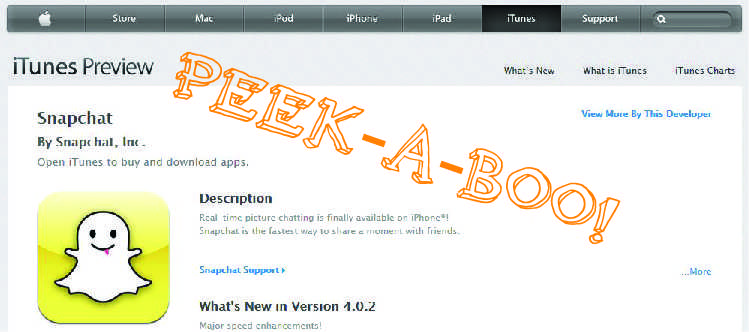Erika Garcia | Opinion Co-editor
Peek-a-boo! Recently, a friendly ghost has begun to appear on the cell phone notification bar of many students. The ghost figure signifies you have a Snapchat image or video waiting for you from someone you know. For those still scratching their heads, let me explain this new app in terms of already existing technology and social media. Snapchat is a photo sharing app based on pictures (like Instagram) in which you can send a picture/video message to a friend who also has a Snapchat account. It was created by four Stanford students. So what sets this apart from picture text messaging, you may wonder? Here is where it gets interesting. Each picture or video you send or receive has a time limit of up to 10 seconds in which you can view the message. Once the time has passed, you can no longer view the picture message no matter how many times you attempt to open it. They simply vanish as the app’s mascot ghost suggests. Dangerous or careless fun?
Because this app has a time limit, one could send just about whatever without repercussions. Perhaps this is one of the traits that make it so popular. I myself use the app because of its convenience and ease when compared to your standard text photo messaging. This is so because you do not have to download the picture; it simply appears. Not to mention, the app is free, meaning some people don’t need to worry about the cost of picture messaging. Snapchat’s success appeared overnight, causing a stir in which Facebook felt threatened enough by the app that the social media giant launched its own version of Snapchat named “Poke.”
The app averages sending over 50 million images each day. That’s right, millions of pictures per day! With that amount being sent on a daily basis, it isn’t hard to think of some negative ways the app is being used. With the alarming statistics regarding sexting has this app made it easier for “sexters” to send images and videos without consequences? Other topics of controversy surrounding the app range from lack of privacy, referring to people taking pictures of unsuspecting people, to bullying. For example, in December, Snapchat was involved in an incident in which an unaware high school female in Hudson, Iowa had her picture taken while changing in the girls’ locker room by another female classmate. The picture was then sent via Snapchat to a male classmate.
Technology and social media can bring ease to our lives, but in order to enable it, we end up giving up part of ourselves in order to fuel it. Usually, that part is our privacy. In this case, Snapchat had a great idea turned into a negative by a portion of its users. This case is not unique to this app alone but rather is a victim like all other forms of social media and technology. If this is the case, are certain populations mature and/or responsible enough to handle such power?
Photo by Tyson Domingo










